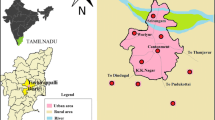Abstract
Levels of 10 heavy metals in cattle egret chick feathers, prey, and surrounding soils from three heronries in Punjab Province, Pakistan, were assessed by atomic absorption spectrophotometry. Mean levels of cadmium (Cd), iron (Fe), chromium (Cr), and lithium (Li) in feathers, manganese (Mn), cobalt (Co), and nickel (Ni) in prey, and lead (Pb), iron (Fe), chromium (Cr), zinc (Zn), cobalt (Co), and lithium (Li) in soils were significantly different among Trimun Headworks, Shorkot, and Mailsi heroneries. Mean levels of Pb (43.10 μg/g), Cr (35.77 μg/g), Co (18.34 μg/g), Cu (0.20 μg/g), and Ni (0.22 μg/g) in feathers were significantly greater at Mailsi, and Mn (3.07 μg/g), Zn (18.83 μg/g), and Li (1.5 μg/g) levels were significantly greater at Shorkot. Multivariate analysis identified that some metals, such as Fe, Zn, and Li, in feathers were either associated with natural sources or with human-related activities, whereas Ni, Cr, Pb, Cd, Cu, Co, and Mn were correlated mainly with anthropogenic processes. Alarming levels were recorded for Cr, Pb, and Cd in feathers that were above threshold levels that may affect cattle egret flighting capacity and reproduction, thus leading to their population decline in Punjab Province. The results of this study provide evidence for the potential of feathers of cattle egret to be used as a biomonitor for the local heavy-metal contamination.





Similar content being viewed by others
References
Anderson O, Phillips R, Shore R, McGill R, McDonald R, Bearhop S (2010) Element patterns in albatrosses and petrels: influence of trophic position, foraging range, and prey type. Environ Pollut 158(1):98–107
Boncompagni E, Muhammad A, Jabeen R, Orvini E, Gandini C, Sanpera C et al (2003) Egrets as monitors of trace-metal contamination in wetlands of Pakistan. Arch Environ Contam Toxicol 45(3):399–406
Bostan N, Ashraf M, Mumtaz AS, Ahmad I (2007) Diagnosis of heavy metal contamination in agro-ecology of Gujranwala, Pakistan using cattle egret (Bubulcus Ibis) as bioindicator. Ecotoxicology 16(2):247–251
Burger J (2008) Assessment and management of risk to wildlife from cadmium. Sci Total Environ 389(1):37–45
Burger J, Gochfeld M (1993) Heavy metal and selenium levels in feathers of young egrets and herons from Hong Kong and Szechuan, China. Arch Environ Contam Toxicol 25(3):322–327
Burger J, Gochfeld M (2000a) Effects of lead on birds (Laridae): a review of laboratory and field studies. J Toxicol Environ Health B Crit Rev 3(2):59–78
Burger J, Gochfeld M (2000b) Metal levels in feathers of 12 species of seabirds from midway atoll in the northern Pacific Ocean. Sci Total Environ 257(1):37–52
Burger J, Gochfeld M (2004a) Marine birds as sentinels of environmental pollution. Ecohealth 1(3):263–274
Burger J, Gochfeld M (2004b) Metal levels in eggs of common terns (Sterna hirundo) in New Jersey: temporal trends from 1971 to 2002. Environ Res 94(3):336–343
Burger J, Gochfeld M (2009) Mercury and other metals in feathers of common eider (Somateria mollissima) and tufted puffin (Fratercula cirrhata) from the Aleutian chain of Alaska. Arch Environ Contam Toxicol 56(3):596–606
Burger J, Rodgers JA, Gochfeld M (1993) Heavy-metal and selenium levels in endangered wood storks Mycteria Americana from nesting colonies in Florida and Costa Rica. Arch Environ Contam Toxicol 24(4):417–420
Burger J, Gochfeld M, Sullivan K, Irons D (2007) Mercury, arsenic, cadmium, chromium lead, and selenium in feathers of pigeon guillemots (Cepphus columba) from Prince William Sound and the Aleutian Islands of Alaska. Sci Total Environ 387(1):175–184
Carpenter JW, Andrews GA, Beyer WN (2004) Zinc toxicosis in a free-flying trumpeter swan (Cygnus buccinator). J Wildl Dis 40(4):769–774
Chen T, Liu X, Zhu M, Zhao K, Wu J, Xu J, Huang P (2008) Identification of trace element sources and associated risk assessment in vegetable soils of the urban-rural transitional area of Hangzhou, China. Environ Pollut 151(1):67
Custer TW, Custer CM, Eichhorst BA, Warburton D (2007) Selenium and metal concentrations in waterbird eggs and chicks at Agassiz National Wildlife Refuge, Minnesota. Arch Environ Contam Toxicol 53(1):103–109
Dauwe T, Janssens E, Bervoets L, Blust R, Eens M (2004a) Relationships between metal concentrations in great tit nestlings and their environment and food. Environ Pollut 131(3):373–380
Dauwe T, Janssens E, Kempenaers B, Eens M (2004b) The effect of heavy metal exposure on egg size, eggshell thickness and the number of spermatozoa in blue tit Parus caeruleus eggs. Environ Pollut 129(1):125–129
Deng HL, Zhang ZW, Chang CY, Wang Y (2007) Trace metal concentration in great tit (Parus major) and greenfinch (Carduelis sinica) at the western mountains of Beijing, China. Environ Pollut 148(2):620–626
Eijsackers H, Beneke P, Maboeta M, Louw JPE, Reinecke AJ (2005) The implications of copper fungicide usage in vineyards for earthworm activity and resulting sustainable soil quality. Ecotoxicol Environ Saf 62(1):99–111
Eqani S, Malik RN, Katsoyiannis A, Zhang G, Chakraborty P, Mohammad A et al (2012) Distribution and risk assessment of organochlorine contaminants in surface water from River Chenab, Pakistan. J Environ Monit 14(6):1645–1654
Fasola M, Movalli P, Gandini C (1998) Heavy metal, organochlorine pesticide, and PCB residues in eggs and feathers of herons breeding in northern Italy. Arch Environ Contam Toxicol 34(1):87–93
Furness R (1993) Birds as monitors of environmental change. In: Furness RW, Greenwood JJD (eds) Chapman & Hall, London
Goutner V, Furness R (1997) Mercury in feathers of little egret Egretta garzetta and night heron Nycticorax nycticorax chicks and in their prey in the Axios Delta, Greece. Arch Environ Contam Toxicol 32(2):211–216
Hansen BH, Romma S, Garmo OA, Pedersen SA, Olsvik PA, Andersen RA (2007) Induction and activity of oxidative stress-related proteins during waterborne Cd/Zn-exposure in brown trout (Salmo trutta). Chemosphere 67(11):2241–2249
Hashmi MZ, Malik RN, Shahbaz M (2012) Heavy metals in eggshells of cattle egret (Bubulcus ibis) and little egret (Egretta garzetta) from the Punjab Province, Pakistan. Ecotoxicol Environ Safe 89:158–165
Honda K, Min BY, Tatsukawa R (1986) Distribution of heavy metals and their age-related changes in the eastern great white egret, Egretta alba modesta, Korea. Arch Environ Contam Toxicol 15(2):185–197
Horai S, Watanabe I, Takada H, Iwamizu Y, Hayashi T, Tanabe S et al (2007) Trace element accumulations in 13 avian species collected from the Kanto area, Japan. Sci Total Environ 373(2–3):512–525
Huang SS, Liao QL, Hua M, Wu XM, Bi KS, Yan CY et al (2007) Survey of heavy metal pollution and assessment of agricultural soil in Yangzhong district, Jiangsu Province, China. Chemosphere 67(11):2148–2155
Hui CA (2002) Concentrations of chromium, manganese, and lead in air and in avian eggs. Environ Pollut 120(2):201–206
Janssens TKS, Roelofs D, van Straalen NM (2009) Molecular mechanisms of heavy metal tolerance and evolution in invertebrates. Insect Sci 16(1):3–18
Jaspers V, Dauwe T, Pinxten R, Bervoets L, Blust R, Eens M (2004) The importance of exogenous contamination on heavy metal levels in bird feathers. A field experiment with free-living great tits, Parus major. J Environ Monit 6(4):356–360
Johansen P, Asmund G, Riget F (2004) High human exposure to lead through consumption of birds hunted with lead shot. Environ Pollut 127(1):125–129
Jones B, Laslett R (1994) Methods for analysis of trace metals in marine and other samples. Ministry of Agriculture, Fisheries and Food, Directorate of Fisheries Research
Kertesz V, Fancsi T (2003) Adverse effects of (surface water pollutants) Cd, Cr and Pb on the embryogenesis of the mallard. Aquat Toxicol 65(4):425–433
Kim J, Koo T-H (2007) Heavy metal concentrations in diet and livers of black-crowned night heron Nycticorax nycticorax and grey heron Ardea cinerea chicks from Pyeongtaek, Korea. Ecotoxicology 16(5):411–416
Kim J, Koo T-H (2008a) Heavy metal distribution in chicks of two heron species from Korea. Arch Environ Contam Toxicol 54(4):740–747
Kim J, Koo TH (2008b) Heavy metal concentrations in feathers of Korean shorebirds. Arch Environ Contam Toxicol 55(1):122–128
Lucia M, Andre J-M, Gonzalez P, Baudrimont M, Bernadet M-D, Gontier K et al (2010) Effects of dietary cadmium contamination on bird Anas platyrhynchos—Comparison with species Cairina moschata. Ecotoxicol Environ Safe 73(8):2010–2016
Malik RN, Zeb N (2009) Assessment of environmental contamination using feathers of Bubulcus ibis L. as a biomonitor of heavy metal pollution, Pakistan. Ecotoxicology 18(5):522–536
Micó C, Recatala L, Peris M, Sánchez J (2006) Assessing heavy metal sources in agricultural soils of an European Mediterranean area by multivariate analysis. Chemosphere 65(5):863–872
Novotny V (1995) Diffuse sources of pollution by toxic metals and impact on receiving waters. In: Novotny V (ed) Heavy metals: problems and solutions. Springer, Berlin, p 33–52
Oliva SR, Espinosa A (2007) Monitoring of heavy metals in topsoils, atmospheric particles and plant leaves to identify possible contamination sources. Microchem J 86(1):131–139
Pan C, Zheng GM, Zhang YY (2008) Concentrations of metals in liver, muscle and feathers of tree sparrow: Age, inter-clutch variability, gender, and species differences. Bull Environ Contam Toxicol 81(6):558–560
Qadir A, Malik RN (2011) Heavy metals in eight edible fish species from two polluted tributaries (Aik and Palkhu) of the River Chenab, Pakistan. Biol Trace Elem Res 143(3):1524–1540
Scheifler R, Coeurdassier M, Morilhat C, Bernard N, Faivre B, Flicoteaux P et al (2006) Lead concentrations in feathers and blood of common blackbirds (Turdus merula) and in earthworms inhabiting unpolluted and moderately polluted urban areas. Sci Total Environ 371(1–3):197–205
Shahbaz M, Hashmi MZ, Malik RN, Yasmin A (2013) Relationship between heavy metals concentrations in egret species, their environment and food chain differences from two wetlands of Pakistan. Chemosphere. http://dx.doi.org/10.1016/j.chemosphere.2013.04.078. Accessed 28 June 2013
Spahn SA, Sherry TW (1999) Cadmium and lead exposure associated with decreased growth rates, poorer fledging success of little blue heron chicks (Egretta caerulea) in south Louisiana wetlands. Arch Environ Contam Toxicol 37(3):377–384
Swaileh K, Sansur R (2005) Monitoring urban heavy metal pollution using the house sparrow (Passer domesticus). J Environ Monit 8(1):209–213
Syed JH, Malik RN (2011) Occurrence and source identification of organochlorine pesticides in the surrounding surface soils of the Ittehad Chemical Industries Kalashah Kaku, Pakistan. Environ Earth Sci 62(6):1311–1321
Tariq SR, Shah MH, Shaheen N, Jaffar M, Khalique A (2008) Statistical source identification of metals in groundwater exposed to industrial contamination. Environ Monit Assess 138(1–3):159–165
Wei BG, Yang LS (2010) A review of heavy metal contaminations in urban soils, urban road dusts and agricultural soils from China. Microchem J 94(2):99–107
Zayed J, Hong B, L’Esperance G (1999) Characterization of manganese containing particles collected from the exhaust emissions of automobiles running with MMT additive. Environ Sci Technol 33(19):3341–3346
Zhang Y, Ruan L, Fasola M, Boncompagni E, Dong Y, Dai N et al (2006) Little egrets (Egretta garzetta) and trace-metal contamination in wetlands of China. Environ Monit Assess 118(1):355–368
Acknowledgment
The authors are grateful to Pakistan Wetland Programme for providing transport during field visits.
Author information
Authors and Affiliations
Corresponding author
Rights and permissions
About this article
Cite this article
Ullah, K., Hashmi, M.Z. & Malik, R.N. Heavy-Metal Levels in Feathers of Cattle Egret and Their Surrounding Environment: A Case of the Punjab Province, Pakistan. Arch Environ Contam Toxicol 66, 139–153 (2014). https://doi.org/10.1007/s00244-013-9939-8
Received:
Accepted:
Published:
Issue Date:
DOI: https://doi.org/10.1007/s00244-013-9939-8




